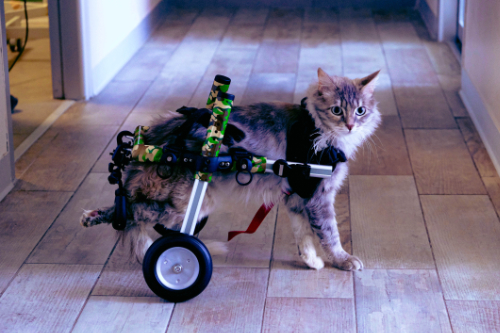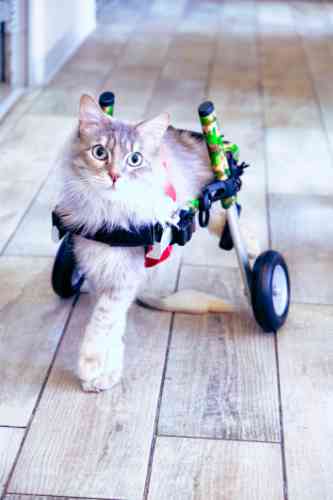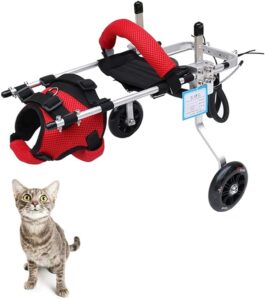Paralysed leg or legs in your cat
How does is happen?
Your cat has a paralysed leg or legs. That’s horrible! Both for him and for you to have to see your cat in pain. It is important that you contact your vet immediately to find out what the cause is. And then what the treatment can be. Below we will explain more about how a paralysed leg or legs in cats usually arise and what can be done about it. Unfortunately, treatment solely by yourself, without the help of a veterinarian, is not a good idea in this case.
What causes a paralysed paw in a cat?
When a cat’s brain is no longer able to register how a paw has been placed, or when the brain can no longer transmit a signal to the muscles to move, this is paralysis. Your cat may still want to move his paw, but he may not be able to get the paw into the right position.
Paralysis can be divided into partial paralysis, where some movement is still possible. But usually there is complete paralysis and no form of movement is possible anymore. In that case, your cat drags its paw or paws across the ground.
What symptoms do you see when a cat has a paralysed leg?
The symptoms you see if your cat has a paralysed leg or legs depend on the cause of the paralysis. The most common symptoms are:
- Dragging one or more legs across the ground
- Unable to support himself on the leg or legs
- The paw is not raised, but “dangles” from your cat’s body
- No reaction to touching the paw (nerve block) or an extreme reaction of pain to a mild touch of the paw (blood clot)
- If there was a collision, nail tips may be split and multiple wounds may be found on the body.
- A cat with a paralysed leg is often (a little) in panic.
- The paw or paws may feel very cold in the event of a blood clot.
What causes a paralysed paw in a cat?
There are many possible causes for paralysis. But the most common causes for a paralysed paw or paws in a cat are vehicle collisions. Secondly, paralysis is caused by a blood clot in the vessels of the hind legs. These are the causes that we will discuss below. In all cases, it is important that you take your cat to your vet to have your cat treated.
Paralysis symptoms as a result of a collision
Does your cat have a paralysed leg or legs? The vet will then first investigate whether there could have been a collision. We do this by carefully checking whether there are fresh broken teeth or molars, whether there are wounds elsewhere on the body, whether there are frayed nails and whether there are bald spots. Typically, a vet will examine all of these things first before focusing on examining the paralysed leg. And there is a reason for that. If a leg is paralysed, there is a chance that there is a fracture somewhere in the body. In the back, in the pelvis or in the leg. If we hurt your cat, it will be more difficult to examine afterwards. It is then no longer safe to take a look in the mouth or at its nails.
Is it clear that there has been a collision? Then we will carefully try to find out where the nerve transmission is blocked. That could be in the back. But the pelvis or leg can also be broken, causing damage to the nerve of that leg. It is of course also possible that it comes from the brain itself, but then we see a different consciousness in a cat. We also want to know whether your cat still has feeling in its paw. That’s why we pinch his paw very viciously. We usually do this with small pliers. We can then see in your cat whether he feels it or not. If he does feel it, then we at least know that the spinal cord or nerves are not completely cut in half. X-rays should then show how bad the problem is and what the treatment can be.
A blood clot as the cause of a paralysed leg or legs
What many people don’t know is that a paralysed leg in cats can also be caused by a blood clot in the blood vessels. This is almost always in the hind leg or hind legs. People sometimes come into the practice completely panicked and have no idea why their cat is paralysed since it never comes outside and therefore can’t have been hit by a car.
As a result of a (usually unnoticed) heart murmur, blood can swirl in the heart. In that case, a blood clot may develop. At first it is still somewhat attached to the wall in the heart, but can suddenly come loose. The blood clot then enters the bloodstream. It then gets stuck at the first place where the blood vessels narrow. In case of a paralysed leg, there is a good chance that the blood clot has ended up at the point where the large body artery (aorta) splits into the two blood vessels that go to the hind legs. After all, the diameter of those two blood vessels is smaller than the diameter of the aorta.
Due to the blood clot, the leg or even both legs no longer receive nutrients and oxygen. As a result, the tissues in the leg can no longer perform their function. Just think of an asleep arm, but 10x worse. You can also make an asleep arm move with difficulty and it feels very strange.
What should you do if your cat has a paralysed paw?
In all cases, it is necessary to contact your veterinarian immediately and have your cat examined. Even at night or on weekends. The sooner your cat receives treatment, the greater the chance of recovery. However, a paralysed leg or legs are very serious problems and the outcome is unfortunately not always favorable. In collisions that result in paralysis, euthanasia may be the most animal-friendly option. And with a blood clot, unfortunately it does not always end favorably, but it is at least useful to try to see if your cat can clean up the blood clot itself.
What treatment is possible for a cat with a paralysed leg?
Treatment for a fracture in the back, pelvis or leg
If there is a broken back or leg, the treatment depends on how serious the damage is. In case of damage to the back, we usually give painkillers and strong anti-inflammatory drugs to reduce swelling in the spinal cord as much as possible. After that your cat will be closely looked after for a few days. This is to know whether your cat is still able to control his bladder and therefore whether he can empty his bladder himself. If that is not possible, the prospects for your cat will unfortunately be quite limited. If your cat can still do this himself, in some cases it is possible to perform surgery on the vertebrae and hope that the spinal cord will recover.
In the event of a fracture to the pelvis or a leg, it is usually necessary to have surgery to stabilize the fracture. The damaged nerve can then hopefully be given the opportunity to repair itself.
In addition, in some cases, instead of surgery, it is decided to limit your cat’s movement as much as possible for 6 weeks and let it recover on its own. He then has to sit in a crate for 6 weeks and is given painkillers in the meantime to counteract the worst pain. The latter option is particularly the best choice if there is a fracture in your cat’s pelvis.
Dissolving a blood clot
If a blood clot turns out to be the cause of all the misery, it will in any case be decided to give your cat anticoagulant medication such as heparin. In some cases, clot-dissolving agents are also chosen, but these sometimes have serious side effects. These are therefore only used if the problem is very serious. Furthermore, a painkiller will of course be given to your cat and it will be ensured that he remains warm and comfortable enough. He must also be able to poop and pee. Of course, in the course of the following days and weeks, the heart must also be examined and what caused the clot to form. In general, cats that survive this will need to be on medication for the rest of their lives to limit the chance of new blood clots forming.
What if your cat stops getting better?
Unfortunately, we have seen many cases where the cat suffered so much damage from a collision with a vehicle that the decision was immediately made to euthanise the cat. Will you decide with your vet to give your cat a chance and hope for recovery? There are still a considerable number of cats that no longer recover sufficiently to have a cat-worthy life. According to research done by J.P. Schoeman only 39% of the cats with this kind of a bloodcloth survived. In another research, done by S.A. Smith and A.H. Tobias there was a survival rate of 45%, but the median survival time after that was only 117 days. Unfortunately, they too are euthanised.
In any case, it is important that your cat can empty its bladder and intestines itself in order to continue to live. Most people also want their cat to be able to walk again. But in some cases, an owner chooses to purchase a wheelchair for a cat. That decision is up to you.
Fingers crossed for recovery!
No cat deserves to have a paralysed leg or legs. But is your cat one of those unlucky ones? In that case we very much hope that he will recover well enough to continue to have a pleasant life. And for your sake we hope that all costs remain limited. Because the costs do increase considerably during a few days for these patients. Good luck and get well soon for your cat!



